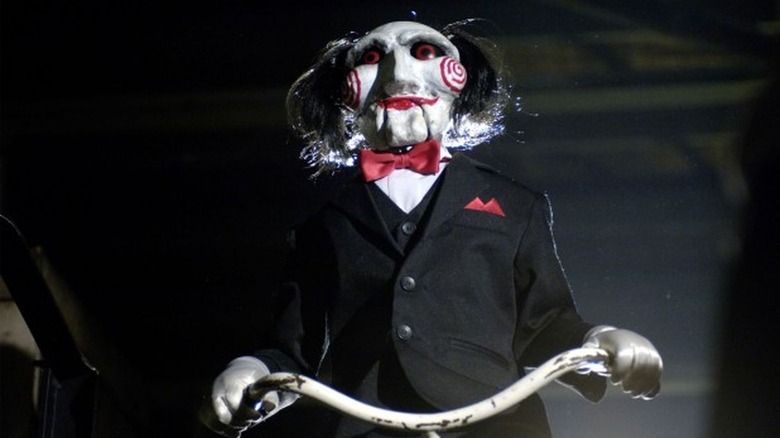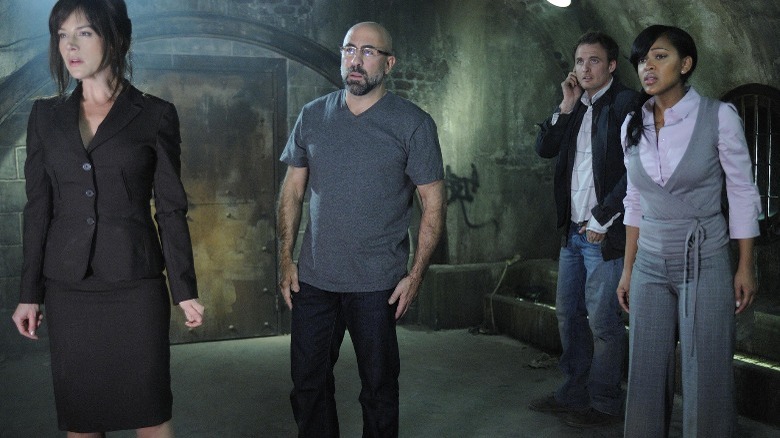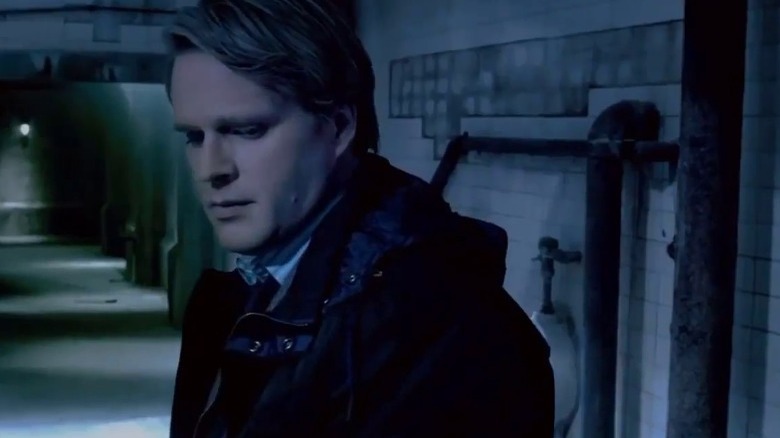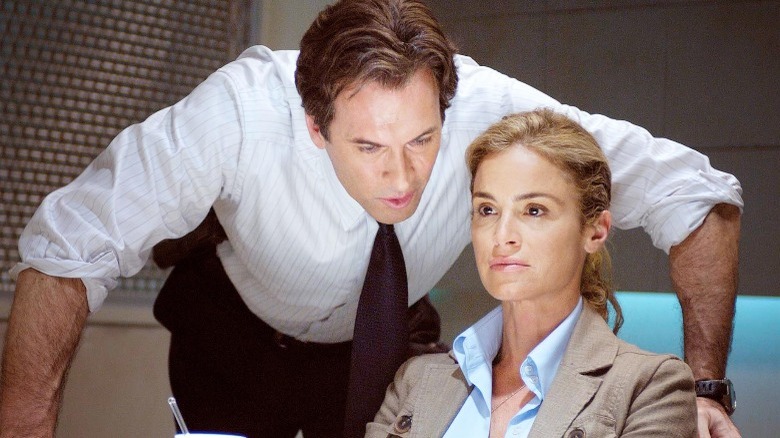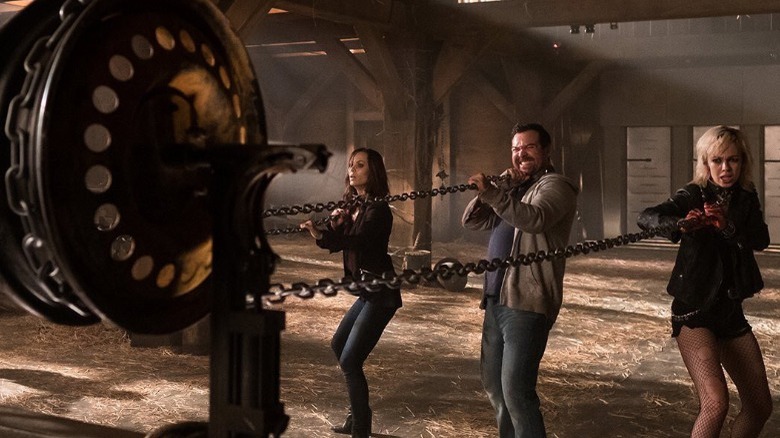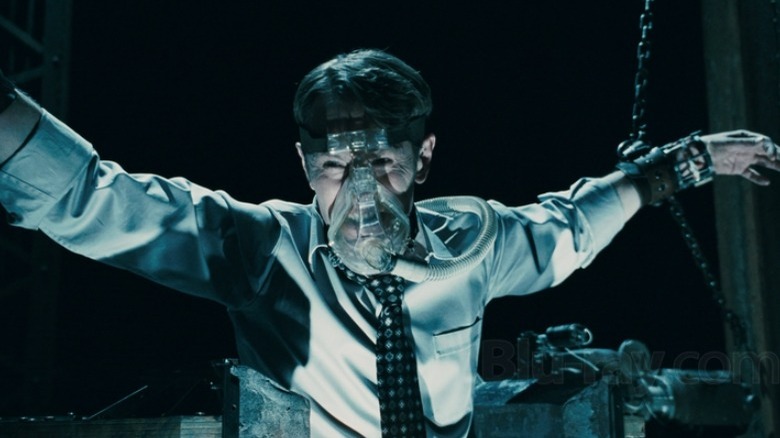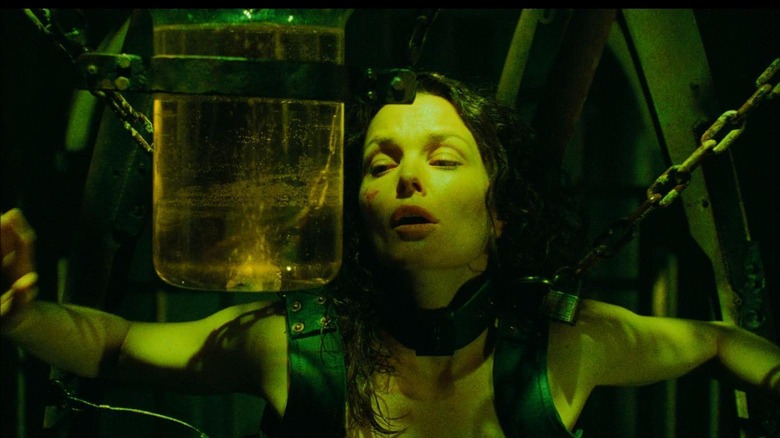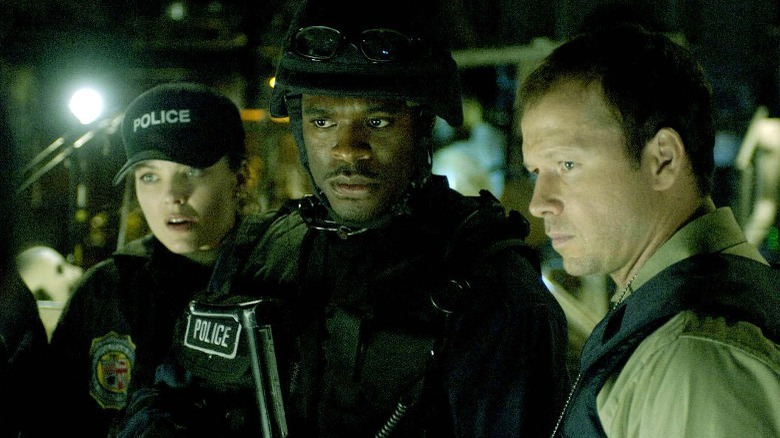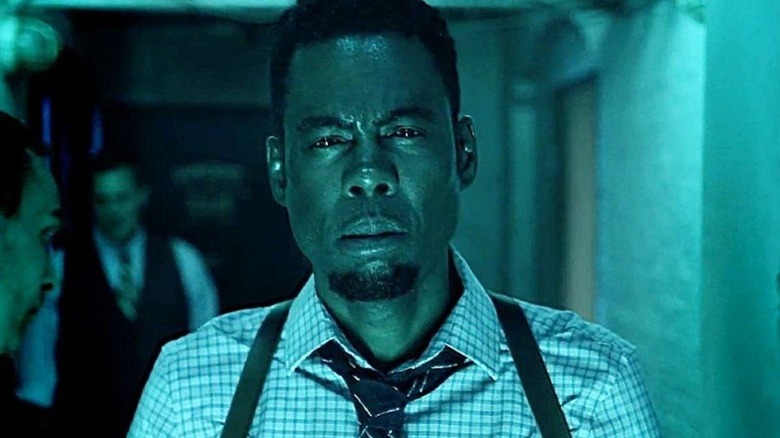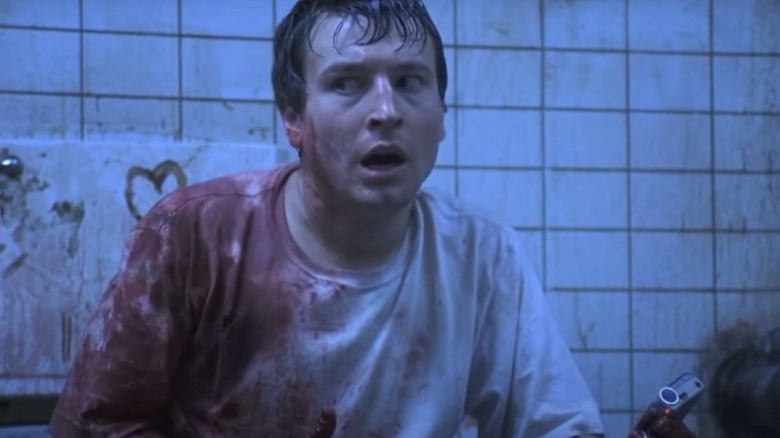Every Saw Movie Ranked Worst To Best
If it's Halloween, it must be "Saw." The franchise, first conceived by genre maestro James Wan and scribe Leigh Whannell, set the horror world ablaze. So much so, that by the time the fourth entry hit theaters in 2007, Lionsgate Films positioned the franchise as part and parcel of the Halloween season itself. Like Michael Myers or Freddy Krueger, franchise antagonist John Kramer, otherwise known as Jigsaw (Tobin Bell) became a horror icon. Often only heard in voiceover through the use of Billy the Puppet — an indelible piece of horror iconography — John Kramer radically subverted horror expectations.
John Kramer, dying from colon cancer, develops a series of tests for those he perceives as taking their lives for granted. He traps ostensible participants in deadly scenarios, forcing them to make difficult choices to survive. While the series postures as some kind of moral imperative, it mostly serves as a series of Grand Guignol exhibitions of outrageous, gory violence. Jigsaw isn't quite the antihero franchise fans make him out to be, but in terms of splattery fun, it rarely gets gooier than the "Saw" franchise. Like the "Final Destination" films, it mostly works as a series of elaborate, gory vignettes. Not every entry is created equally, and like most longstanding horror franchises, there are some duds among the proverbial treasures. In honor of the forthcoming 2023 sequel, here are all the "Saw" movies ranked worst to best.
Saw V
Antagonist John Kramer dies at the conclusion of "Saw III." From there, the series stretched believability, with a series of acolytes carrying on Kramer's legacy. As a Halloween staple, the franchise was all but inaccessible to newbies by this point. "Saw V" was the first entry aside from the first to not top the weekend box office upon release.
While the periphery is filled with Detective Mark Hoffman's (Costas Mandylor) nonsense, the central game yields promise. Five participants with a shared history awaken in an underground sewer and must endure a series of games to survive. Unfortunately, they're among the worst the series has ever seen, ignoring conspicuous clues and generating frustration amid all the bloodshed. At the conclusion, it's revealed that all five could have survived had they worked together, though the ironic twist comes off as too little, too late. At that point, audiences are likely wishing none of them had made it if only to save them from any more of the film's ridiculous, moral-majority histrionics.
Saw: The Final Chapter
"Saw: The Final Chapter" just barely edges out "Saw V" by dint of being the ostensible end. By this point, the franchise had long since run its course, with even diehard fans tired of the quotidian machinations of Jigsaw and his apprentices. They'd seen every severed arm and gouged eye one too many times before. Curiously, "Saw: The Final Chapter" also went by the title "Saw 3D" because, well, it was released in 3D, a gimmick that had an inexplicable chokehold on early 2010s cinema.
"Saw: The Final Chapter" only looks better in retrospect. With two additional entries released afterward, it's easy to forgive the film for failing to cultivate any sense of finality. It's more of the same with a misguided focus on wrapping disparate threads than doing what the series does best — spill blood. Absent John Kramer, there's no central thread, and the likes of Hoffman or Jill (Betsey Russell), as Kramer's wife, fail to generate anywhere near as much interest as the main man himself. The deaths are cartoonish, the characters dull, and the final twist is a ridiculous development that, while shocking, doesn't make an enormous amount of sense. As a final chapter, it fails, but as another notch in Jigsaw's blade, it's merely lackluster.
Saw IV
"Saw IV" is grim and not necessarily in a good way. Opening with the autopsy of the Jigsaw Killer, the series is fully committed to shifting away from Kramer to a series of dull followers. Daniel Rigg (Lyriq Bent), a police officer, is committed to rescuing Jigsaw's victims. Consequently, he finds himself the central subject of the late Jigsaw's latest game, which has him bouncing between different locales, trying to save someone, failing spectacularly, and moving on.
While "Saw IV" does have a good central idea (Kramer's manipulation is so strong that his work endures after death) it never amounts to anything but more of the same — grimy, decrepit locations abounding with shrieking, unlikable victims. There's no moral core, no juxtaposition for all the ugliness and savagery on display. Worse still, it's the entry that solidifies Mark Hoffman as the new central antagonist, a decision the series would never fully recover from.
Jigsaw
The Spierig Brothers are talented filmmakers. Their 2014 Heinlein adaptation, "Predestination," is one of the best sci-fi movies of the century. "Daybreakers" is a rollicking, pulp-heavy vampire saga. Even their first feature, "Undead," injected considerable life into the waning zombie subgenre. It's a shame, then, that "Jigsaw" plays it so safe. Seven years after the final chapter, "Jigsaw" is both a prequel and sequel. With the "torture porn" subgenre dying, "Jigsaw" is less perverse, less icky than any other entry. In other words, it's accessible to mainstream audiences — for better and for worse.
Although the Spierig Brothers deserve credit for making the best-looking "Saw" movie to date, tension is all but nonexistent. It's nothing groundbreaking, but for a series abounding in sickly greens and haphazard camerawork, it's nice to see a "Saw" movie that looks like an actual movie and not some grindhouse student film. Additionally, some of the traps, including a silo set piece, are wickedly effective. Yet, "Jigsaw" lands with a whimper, not the roar of a chainsaw. It's not outright bad, but it never once justifies the return of the iconic Jigsaw seven years after the last.
Saw VI
"Saw VI" is widely regarded as the best of the later sequels. Most, if not all, of its positive reception can be credited to its ingenious, vicious traps. "Saw VI" is still bogged down by unnecessary subplots, but it elevates itself by delivering exactly what fans want from a sixth entry. It's gory, ridiculous, and probably the closest the series has gotten to having a genuine contention to make.
Health insurance executive William Easton (Peter Outerbridge) leads the charge as the latest poor sap involved in one of Jigsaw's games. As he navigates his predicament, he repeatedly encounters coworkers, often having to make difficult decisions about who lives or dies — decisions that parallel the minutiae of his career. Notably, "Saw VI" features one of the series' best traps. Six of William's subordinates are strapped to a carousel with a loaded shotgun mounted at its center. Will can only save two of them, and what follows is a genuinely tense fight for survival. Admittedly, the series didn't quite maintain what marginal goodwill "Saw VI" brought it, but as an isolated beat in a bloated franchise, it's a breath of fresh air.
Saw III
"Saw III" might as well be the beginning of the end for the franchise. Culminating in the death of killer John Kramer and O.G. acolyte Amanda (Shawnee Smith), the series had nowhere left to go. Resultantly, it added twist upon twist, subplot upon subplot, until the franchise all but demanded a series bible of its own for anyone to understand exactly what was going on. "Saw III" does have a lot going on. There are three different subplots, though the most important are the ones involving Jigsaw, Amanda, and kidnapped doctor Lynn (Bahar Soomekh), and those involving Jeff (Angus Macfadyen), Jigsaw's latest victims.
It is a lot, with "Saw III" cross-cutting between Jeff's game and his test of atonement for those responsible for the death of his son, and Jigsaw and Amanda keeping Lynn hostage as she performs lifesaving surgery for John. The traps are fine, though there is an interesting wrinkle thrown in. Some of the tests have no chance of survival, breaking a core component of Jigsaw's modus operandi. It's nothing groundbreaking, though it does culminate in a savage twist that marks one of the last times the series would manage to surprise rather than confound.
Saw II
As with most horror franchises, the second entry in the "Saw" series is the best of the original sequels. With an expanded cast, more tests, and the full breadth of the Jigsaw killer's plans starting to develop, "Saw II" is a noteworthy template for how a movie as contained as "Saw" could work within the franchise template. Desperate to find his son, Detective Eric Matthews (Donnie Wahlberg) subdues Jigsaw. He gains access to video footage of his son and several other players in an unknown home.
Like other entries later in the series, "Saw II" cuts between the procedural investigation and the game at hand. With distinct personalities, the six players in the house are compelling, even as they make some pretty ludicrous decisions in their quest for survival. With a gangbusters final twist, the ascension of acolyte Amanda, and more bloody thrills, "Saw II," is exactly what fans of the series hoped for in a sequel. It isn't perfect, but it's competently directed, certifiably tense, and as gross-out gory as audiences wanted.
Spiral
"Spiral," otherwise known as "Spiral: From the Book of Saw," doesn't quite reinvent the wheel, but it is the best "Saw" sequel the series has seen. With Chris Rock and Samuel L. Jackson at its center and a script by perennial horror scribe Josh Stolberg, "Spiral" is the most accessible entry outside of "Jigsaw," a torture porn revival that grosses out without going too far.
Rock stars as Detective Zeke Banks, the chief investigator of a new series of slayings the police department attributes to a Jigsaw copycat killer. Jackson portrays Marcus, Zeke's father, a former police chief core to Zeke's investigation of the copycat killer. "Spiral" is certainly gory, and at the time of its release, considerably more hardcore than most horror offerings had been in years (it is a "Saw" movie, after all). Still, in terms of mainstream appeal, it's easy to see how "Spiral" is the third top-rated in the franchise on Rotten Tomatoes. It's not a horror classic, but 17 years after the first "Saw," it's impressive just how much "Spiral" does right.
Saw
In a surprise to absolutely no one, James Wan's "Saw" is by far the strongest entry in the series. Interestingly, "Saw" subverts the expectations of other horror franchises by dint of a pretty lukewarm critical reception at release. Although the first "Halloween," "Scream," and "A Nightmare on Elm Street" entries were critical darlings, "Saw" was never all that popular outside of diehard horror audiences. It makes sense, given how Wan's first is a brutal foray into the grungiest, grimiest kind of horror.
"Saw" is not an easy watch, especially for mainstream audiences, likely accounting for its C+ Cinemascore, one of the lowest of the entire franchise. The deft touch of Wan and writer Leigh Whannell cannot be understated. Even with material weaker than what contemporary fans might expect, the duo made something special with their yarn about serial killer Jigsaw forcing his victims to make tough choices to survive. The cast is strong, the tension suffocating, and Wan's artistry is on full display. Not to mention, with both "Saw" and "The Conjuring," Wan has created two of the most profitable horror enterprises of the century. That's scary good stuff.
